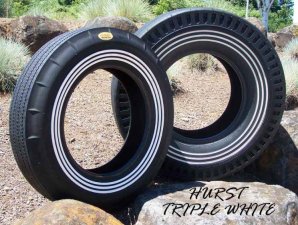An original spare is there for two reasons, looks and an emergency. When an emergency arises you use it to get the car to where it needs to go and thats it
Ok then.........
Tire Aging
Tires, like any other rubber product, have a limited service life regardless of tread depth and use. (Rubber is an elastomer, which constantly changes it properties due to its exposure to air (oxidation), heat and other environmental factors) As tires age, their physical and chemical properties degrade reducing their margin of safety. You would think that a tire should be designed such that the tire fatigue life exceeds the tread life by some safety margin. But the U.S. tire industry has done nothing to warn us about the risks of old tires.
Whether a tire is old and unsafe cannot be detected by the naked eye. Tires undergo an aging process even when the are not in use. The rubber loses its elasticity, the steel webbing corrodes and the rubber hardens. A tire that has been in storage for years will look brand new and is extremely dangerous.
Some experts take the position that a tire is unsafe after 4 years whether it was used or not, others say 6 years, but the tire industry will not make such a statement. A former Michelin tire engineer advocated "sell by" or expiration dates back in the 1900's, but the tire industry has ignored such requests.
In the 1990's, the owners manuals for various German cars such as Mercedes and BMW as well as Toyota indicated that tires more than six years old could be dangerous.
The problem has historically been with the spare tire. It just sits in the back, even though you replace the other four tires as the tread wears out, you keep the spare because it looks brand new. Full sized spares are less common today as vehicle makers opt for the temporary donut. But full size spares are frequently found on SUVs, pickups and vans, vehicles more susceptible to rollover in the event of a catastrophic tire failure.
If the tire industry put expiration dates (which the general public could read and understand) on tires, it would initially cost them a lot of money, because they would have to recall their old tires. Tire age can be determined by decoding the DOT (Department of Transportation) number molded into the sidewall of the tire- however this process can be difficult and confusing, and often requires a tire expert.
Due in large part to the Firestone Tire recall in August 2000 (See Article "Global Recall: The History of the Firestone Tire Debacle") the Automobile and Tire industry have issued various responses.
In 2001, the British Rubber Manufacturers Association strongly recommends that unused tires should not be placed into service if they are more than 6 years old. In 2005, Ford Motor Company announced a six (6) year recommendation as well, regardless of tread wear. Of course, tire manufacturers were much more lax in there assessment of the issue. In October, 2005 Bridgestone Firestone recommended that all tires should be replaced after 10 years. Continental and Michelin soon followed, echoing the 10 year period set forth by Firestone.

















